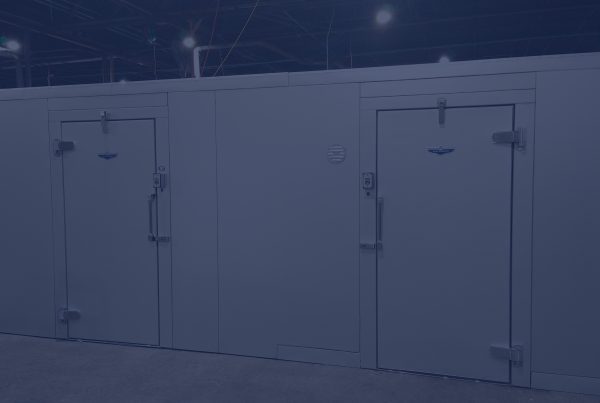It’s important to carefully select your walk-in because it’s a major purchase that will have a lasting effect on the operation of your business. Before diving headlong into this purchase, here are a few items to consider before making this decision.
- Storage Space – If you’re running a restaurant, you will need approximately 1.5 cubic feet of storage space for every meal you serve per day. Read this article for a more in-depth sizing formula. It’s better to have too much storage space than not enough. However, your walk-in shouldn’t be exorbitantly large because your monthly operating cost generally increases as its size increases.
- Location of Box – Whether you’re going to locate your walk-in indoors or outdoors, make sure you have adequate space to accommodate the box. Outdoor walk-ins will require a rainroof, refrigeration hood and a drip cap for over the door (if the door doesn’t open from within the building). Assess the floor to make sure it’s suitable for load-bearing. If you have a concrete floor, a walk-in cooler can be placed on it. If the walk-in is going on a wood frame floor, it will require floor panels. A walk-in freezer always requires an insulated floor.
-

A walk-in with remote refrigeration.
Refrigeration System – Confirm that you are getting a refrigeration system that is sized correctly for your walk-in. If your system is underpowered it will run often and wear out quickly. If your system is overpowered it will not cycle enough to effectively remove humidity from the box and may cause icing. There are different types of refrigeration systems with different purposes and benefits. For example, remote refrigeration can be located outdoors when your walk-in is located indoors. This is beneficial because you’re not adding heat or noise to the room where the walk-in operates. It’s also important to know the voltage requirements for your building (single or 3 phase power). In general, commercial buildings will use 3 phase power and residential will use single phase. Learn more about the different types of refrigeration for walk-ins.
- Design features and Accessories – Do you need a strip curtain for energy efficiency, a temperature alarm to alert you that your refrigeration is not functioning properly, a kickplate to protect the door, or an internal or external ramp to help you wheel carts into the freezer? Make a list of additional features you want in your walk-in. It’s better to bundle any add-ons with your walk-in purchase because they are often sold at a lower markup vs. buying aftermarket.
-

Extruded polystyrene may be blue or pink depending on the manufacturer.
Quality – Quality is not something you want to skimp on with your walk-in cooler or freezer. A cheaply purchased box can sometimes mean inflated electricity costs over the life of the walk-in. The initial sticker price is sometimes the only consideration instead of what the walk-in will cost you in the long run. Quality LED lighting and refrigeration will be more expensive but it can save you considerable amounts on energy costs over the life of your walk-in. See what kind of insulation is available and how it will affect the price and efficiency. It’s important for your walk-in to have a high initial R-value but also investigate how much of the R-value will be retained over the life of the product.
- Manufacturers – There are many manufacturers of walk-in coolers and freezers. Some sell locally and some sell on a national or international level. They also vary in terms of quality, price, EISA compliance and design options available. If you have a preferred equipment supplier, ask them what manufacturer they recommend and why. It’s always a good idea to do research online on the manufacturer or call or email them with questions you have that are not clarified on their website.
- Dealers – Walk-ins are sold through dealers such as HVACR and foodservice companies who then resell to end users like c-stores and restaurants. If you do not already have a dealer you are comfortable working with, ask the manufacturer for a reputable dealer in your area.
- EISA Compliance – The Energy Independence and Security Act that sets standards for walk-in coolers and freezers went into effect January 1st, 2009. Not all manufactures are complying with these requirements and are selling boxes with cheap insulation that doesn’t meet the R-value requirements (R-25 for cooler, R-32 for freezers) or refrigeration that doesn’t meet efficiency standards. Make sure the manufacturer is aware of EISA requirements and fully compliant with them. To meet current requirements manufacturers will use insulation that is at least 4 inches thick of Extruded Polystyrene or Foamed-In-Place Polyurethane.
- Extra Costs – If for example, you’re buying from a walk-in manufacturer in Florida and you live in Washington, freight is going to be a major expense. Always ask for a freight estimate up front. Likewise check your tax liability. If a manufacturer or dealer has a sales presence or location in your state you may be charged sales tax. The installation of your walk-in should be done by your dealer, or a contractor. The refrigeration system must be installed by a licensed refrigeration contractor. Make sure you’re made aware of all costs before committing to buy.
-

Walk-ins are shipped unassembled in stacks of panels.
Shipping & Lead Time – For a custom designed walk-in, the standard industry lead time is about 2 weeks, but this can easily fluctuate based on manufacturing material supply and consumer demand. If you need a walk-in that’s not a typical shape or size, one that needs non-standard refrigeration or any component that must be ordered, see how this will affect your lead time. For example, ordering glass merchandising doors or side access doors may add to your lead time. Walk-ins are shipped unassembled in stacks of panels on skids. If you do not have a forklift available, you will need to pay for a lift gate service.
- Warranty – Ask what the warranty is for panels, refrigeration and walk-in hardware and the process for making a warranty claim in the event something is damaged or malfunctioning. Consider extended warranty plans if available.
 We hope that this guide will help you make an informed decision on your next walk-in. If you would like to get a no obligation price quote from U.S. Cooler, call 800-521-2665 or fill out our online quote form.
We hope that this guide will help you make an informed decision on your next walk-in. If you would like to get a no obligation price quote from U.S. Cooler, call 800-521-2665 or fill out our online quote form.
If you would like to get better organized, download the Walk-in Ordering Worksheet. It’s a place you can save all the info about your walk-in order including box requirements, a research checklist, order info, vendor info, and client info if you will be reselling the walk-in. This is a fillable-pdf, so it can be filled out on your computer, saved for later editing, emailed or printed out.




Cool post! Thank you for all of the tips when it comes to purchasing a walk-in freezer. I like how you explained that “It’s better to have too much storage space than not enough. However, your walk-in shouldn’t be exorbitantly large because your monthly operating cost generally increases as its size increases.” I have never bought a walk-in freezer before but I can just imagine how much extra space it can provide for commercial food services.
Taking the ovwreiev, this post hits the spot